EBERLE RTR R1T Bruksanvisning
EBERLE
temperaturkontroller
RTR R1T
Läs gratis den bruksanvisning för EBERLE RTR R1T (4 sidor) i kategorin temperaturkontroller. Guiden har ansetts hjälpsam av 23 personer och har ett genomsnittsbetyg på 4.0 stjärnor baserat på 12 recensioner. Har du en fråga om EBERLE RTR R1T eller vill du ställa frågor till andra användare av produkten? Ställ en fråga
Sida 1/4

1. Applications
This electronic temperature controller is designed for controlling
the room temperature in conjunction with:
• heating systems e.g. hot-water heaters, convector heaters or
oor heating
• electric convector heaters, ceiling and storage heating
• night storage heaters
• circulation pumps
Features
• very easy to program
• basic control mode (start without timer)
• night-time set-back via internal timer
• 3 programs available (7 days, 5/2 day, On-Timer)
• simple switching from comfort to set-back temperature via a
pushbutton
• indicator lamps for „controller calls for heat” and for „set-back”
operation
• 2-pole heater switch (stand-by, controller remains on mains, load
will be switched o)
2. Description of functions
2.1 Functions
The room temperature is measured by the internal sensor and
adjusted via the outer dial.
The scale *…6 corresponds 5…30°C.
Note: As long as the timer is not set, comfort temperature will be
controlled (Basic control mode)
Pushbutton
The pushbutton allows switching between comfort and set-back
temperature. If set-back mode is selected, the green lamp will
be lit.
The selected temperature will be valid until the next switching
point in the program (not for basic control mode).
The program can be changed via the pushbutton, see 2.3.
Heater switch
It switches ON or OFF the heater, the controller electronic remains
on power supply (timer continues to run).
Lamps
Red: Controller calls for heat
Green: Set-back mode is activated
Programs
Basic control mode
After switching on the rst time, the basic control mode is
activated.
As long as the timer was not programmed, the controller works
without time-program. If the timer was set once, the controller
works with the time-program until Master-Reset will be activated
see 2.5.
In mode ON-Timer the basic control mode will not be used.
Setting programs
One of the following programs can be selected:
7 Days: Set-back for 7 hours on each day
5/2 Days: Set-back for 7 hours from Sunday night until
Thursday night. On Friday and Saturday night, there
will be no setback.
On-Timer: Pressing the pushbutton will set the system to
comfort temperature for 2 hours.
No program: Change over of temperatures via pushbutton.
The set-back time, or timer time, can be adjusted (see 2.3).
Function of the 7 days and 5/2 day programs
(set-back time)
Once the set-back timer is set, the selected programs will be
repeated every 24 hours.
Example:
If the timer is set at 22.00 h, the set-back temperature will be
eective for 7 hours starting at 22.00 h. From 5.00 h, the comfort
temperature will again be eective, until 22.00 h.
ON-Timer function
(short time comfort temperature)
Pressing the pushbutton will set the system to comfort temper-
ature for 2 hours. After that, the set-back temperature will be
eective. Setting the time see 2.3.
Selecting the programs via jumpers (see 5)
Program J1 J2
7 days (pre-set) closed closed
5/2 Days closed open
On-Timer open closed
No Program open open
Single pole assembly prevents loss of jumpers.
2.2 Setting the timer
- Press and hold the pushbutton
- When the red lamp lights up, release pushbutton
From this moment, each day the set-back temperature will be
activated.
When selecting the 5/2 day program, the timer must be set on
Sunday evening.
After a voltage failure > 4 h (red lamp ashes), the timer must
be set again.
Room temperature
Principle of setting the timer
comfort
temperature
se backt-
temperature
Time
5:00 o'clock
e.g. 22:00 o'clock
Lamp green = off
Lamp green = on
press key until red lamp is
on, that's it
2.3 Programming the set-back time or on-timer time
(Only necessary if times other than the factory pre-sets are
desired)
The following times can be adjusted.
5/2 days, 7 days:
– Number of hours for set back temperature
(factory pre-set = 7h), Range 1…23 h
On-timer:
– Number of hours for comfort temperature
(factory pre-set = 2h), Range 1….23 h
Perform the steps described below:
a. Start programming
Press and hold pushbutton.
When the green lamp lights up, release pushbutton
(The red lamp which comes up before, has to be
ignored)
b. Reading the current values
The red lamp ashes. The number of ashes
indicates how many hours are currently set
c. Set hours
for each hour, press the pushbutton once, e.g. for 8 h,
press pushbutton eight times
d. Finish programming
Press and hold pushbuttons until both lamps
switch o.
If the hours are only to be read, it is not necessary to perform
step „c” and „d”.
* If the pushbutton is not pressed for more than 20 seconds dur
-
ing programming, the adjustment mode will be aborted and the
current values are kept.
2.4 Selecting the set-back temperature
Press and hold pushbutton until both lamps light up
(the single red and green lamp before has to be ignored).
Release button:
The actually selected set-back temperature will be displayed.
green lamp = set-back by 3°C
red lamp = set-back by 5°C
(Werkseinstellung)
Click button for changing temperature.
Press and hold button until LED goes o. See note * at the end
of 2.3.
2.5 Master Reset (Restoring factory settings)
Press and hold pushbutton until both lamps start blinking
(the single red and green lamp before has to be ignored).
Then press pushbutton again until both lamps go o.
See note *at the end of 2.3.
Now the basic control mode is active. If necessary, the set-back
timer has to be set again see 2.2. If the jumpers will be modied,
Master-Reset will be carried out.
2.6 Voltage failure
In the event of a voltage failure lasting more than 4 hours
(after powered for min. 1h), only the set-back timer has to be
set. All other data (adjusted program) will be kept (if used).
A ashing red lamp indicates if the set-back timer must be set.
2.7 Remote sensor
For measuring the room temperature in a dierent location, a
remote sensor can be used instead of the internal one. If the
remote sensor is connected, the internal one automatically will
be disabled. In case of sensor fault, the internal sensor will be
activated.
2.8 Function of the lamps
Function Green lamp Red lamp
Heating is on on
Set-back mode on
Set-back timer
to be set
ashes
Programming, press key until:
Starting the
set-back timer
on ~ after 3 sec
Set-back time,
on-timer timer
on ~ after 9 sec
Set-back
temperature
on ~ after 12 sec on
Master Reset ashes ~ after 15 sec ashes
3. Mounting / Commissioning
The controller should be mounted at a location in the room
which:
• can be easily accessed
• is free of curtains, cupboards, shelves etc.
• allows free air circulation
• is not exposed to direct sunlight
• is not draughty (when doors or windows are opened)
• is not directly inuenced by the source of heat
• is not located on an outer wall
• is approx. 1.5 m above the oor.
Electrical connection
Caution! De-energize the electric circuit rst.
Perform the steps described below:
• Pull o the temperature adjustment button
• Release the xing screw
• Remove the upper part of the casing
• Connection acc. to circuit diagram (see bottom)
Remote sensor F 193 720 (if used)
Do not install the sensor close to mains cables. In other cases a
shielded cable has to be used.
The sensor can be extended to max. 50 m by means of a cable
suitable for mains voltage.
Caution! Sensor leads carry mains voltage (230 V).
4. Technical data
Order designation RTR R1T
EDP No.: 517 1144 5…
Temperature setting range:
Room temperature
*…6 (5…30ºC)
Indicator lamp red
green
call for heat
Set-back temperature
Heater switch ON/OFF 1-pole (stand by)
Supply voltage 230 V AC (195…253 V) 50 Hz
Power reserve
^ 4 h
Output Relay make contact
Switching current: 10mA…16A cos = 1; ϕ
10mA… 4 A cos = 0,6ϕ
Control algorithm Proportional controller
(similar to continuous
through PWM)
Switching temperature
dierential
~ 0,5 °C
Temperature sensor:
Remote sensor Type
internal
F 193720 (as accessory)
(length 4 m, can be extended
up to 50 m)
Temperature set-back 3°C or 5 °C selectable
Range limitation insight the adjustment dial
Protection class of housing IP 30
Software class A
Pollution degree 2
Rated impulse voltage 4 kV
Ball pressure test
temperature
75 ± 2 °C
Voltage and Current for
the for purposes of
Interference measurements
230 V, 0,1 A
Class of housing II (see Caution! on page 1)
Ambient temperature 0…40 °
Storage temperature –25…70 °
Weight 90 g
Energy class IV = 2 %
(acc. EU 811/2013, 812/2013, 813/2013, 814/2013)
Sensor characteristics
10°C 30°C66.8 kΩ 26.3 kΩ
20°C 40°C41.3 kΩ 17.0 kΩ
25°C 50°C33 kΩ 11.3 kΩ
5. Wiring Diagram
Position of Jumper
J2
J1
Dimensions
Remote sensor F 193720 (Accessory)
Caution!
The device may only be opened and installed according
to the drawing on the device or these instructions by an
authorized electrician. The existing safety regulations must
be observed.
Appropriate installation measures must be taken to achieve
the requirements of protection class II.
This independently mountable electronic device is designed
for controlling the temperature in dry and enclosed rooms
only, under normal conditions. The device conrms to EN
60730, it works according operating principle 1C.
468 931 003168-7
Mounting and
operatinginstructions
easyTimer,
electronic room temperature controller
with time program
easyTimer R1T, 517 1144 5…
Heating
ON/OFF
green indicates
„set-back temperature”
red indicates
„calling for heating”
setting knob for
comfort tempera-
ture ( … 6 corresd-
ponds to 5…. 30°C)
setting knob,
switches between
comfort and set-back
temperature, or for
change settings
This product should not be disposed of with house-
hold waste. Please recycle the products where facili-
ties for electronic waste exist. Check with your local
authorities for recycling advice.
Produktspecifikationer
| Varumärke: | EBERLE |
| Kategori: | temperaturkontroller |
| Modell: | RTR R1T |
Behöver du hjälp?
Om du behöver hjälp med EBERLE RTR R1T ställ en fråga nedan och andra användare kommer att svara dig
temperaturkontroller EBERLE Manualer
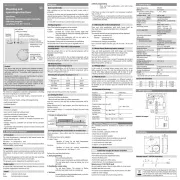
25 Augusti 2025
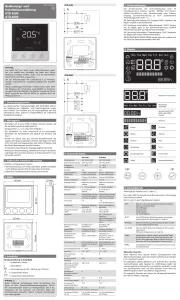
24 Augusti 2025
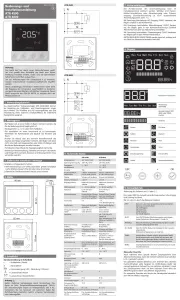
21 Augusti 2025
temperaturkontroller Manualer
Nyaste temperaturkontroller Manualer
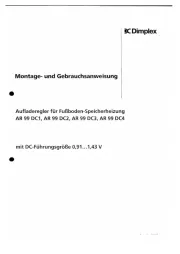
28 September 2025
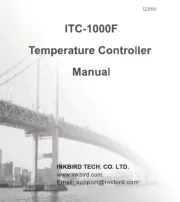
26 September 2025
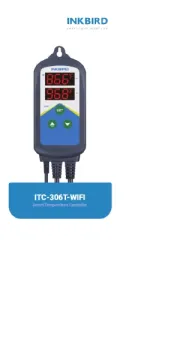
26 September 2025
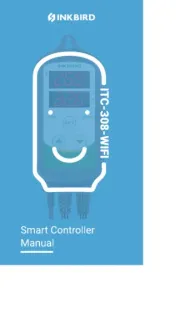
26 September 2025
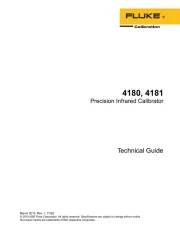
25 September 2025

25 September 2025

25 September 2025
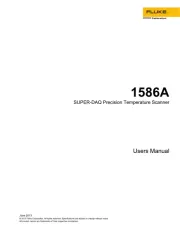
25 September 2025
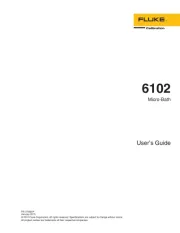
25 September 2025

25 September 2025